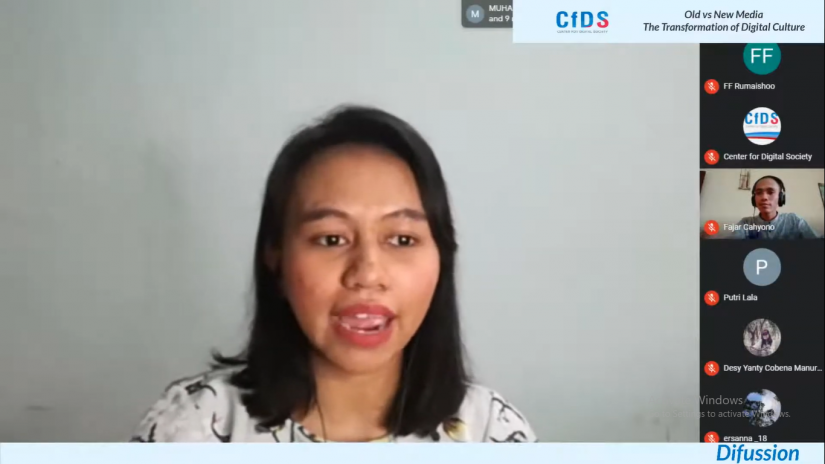
Yogyakarta, September 18th 2020—Center for Digital Society (CfDS) FISIPOL UGM came back with another Difussion #34 called Old vs New Media: The Transformation of Digital Culture with Mira Ardhya Paramastri and Theodore Great Aipassa as the Research Associate of CfDS. The discussion was held on YouTube Live.
It started with the explanation of Old vs New Media: Can Government Regulate Digital Media by Theodore Great Aipassa, the discussion began with a question, “Does the new media need to be regulated by the government?”
“The transformation of digital revolution brought up the characteristics of new media. Back then, media in Indonesia was highly centralized with only one TV channel, it was TVRI, then it developed and transformation happened where the media became decentralized marked by the emergence of new TV channels. For example, the ownership of TV stations is still centralized but the channels are increasing,” Great said.
“Then the development of technology, media is no longer decentralized but continues to a distributed stage where everyone who has internet access can upload and share the contents via YouTube and other social media. But the content distribution has its own positive and negative sides. The positive thing is, everyone can share their contents, from education to financial literacy which can bring people into communities,” Great said.
“But the amount of new content can bring up negative impacts, especially for the underage children and teenagers whose emotions are unstable. Unfortunately, these things can not be avoided because technology will be integrated with our lives and there must be a regulation,” Great said.
In making a new regulation, Great explained three difficult dilemmas and the difficulty in implementing these rules. First, the regulatory area which includes the international area where content can come from various countries. Second, actors who are authorized to implement regulations. Third, the number of workers that needed to monitor new media content.
“Even though the new platforms such as Netflix that already had its own regulations to regulate their contents, and the new media such as YouTube, Facebook, and Twitter, which already had thousands of workers to monitor their contents, there are still things beyond control because of the large amount of content that appears every day,” Great said.
For Great, the proposed solution regarding the regulation of new media regulations is primarily concerned with the right to freedom of expression. “Do not let regulations eliminate people’s rights, whether the content must always be monitored, whether opinions against the government will be prosecuted, and so on,” Great said.
Through this, it is important for collaboration between governments and new media institutions to make proper regulations. Technology must also create algorithms capable of monitoring content quality. Finally, it is also important to involve users to monitor content independently.
The next explanation was Mobile Gaming in Indonesia: Relationship through New Media which was presented by Mira Ardhya Paramastri that conducted research about how digital society creates community clusters, one of that is created through mobile games.
“The development of social media is very fast, online socializing can also be done through mobile gaming applications where the mobile gaming business in Indonesia is very high with 43 million users,” Mira explained.
The interaction through the mobile game creates three types of relationship. First, existing relationships or relationships that already exist in influencing users to play, for example from family, peer relations, to online shop advertisements.
Second, In-Game relationship, where playing games creates relationships to meet new friends on the platform and as a recreation room. Third, Outside-Game relationship, which is a relationship that is strengthened outside the game platform by maintaining relationships outside the platform through meet ups with communities in the real world.
“Through that mapping, this research proved that this new relationship formed after playing online games by involving in the community. Mobile game players also want to carry out social interactions where the digital community makes active clusters of interconnected communities,” Mira concluded the discussion.
